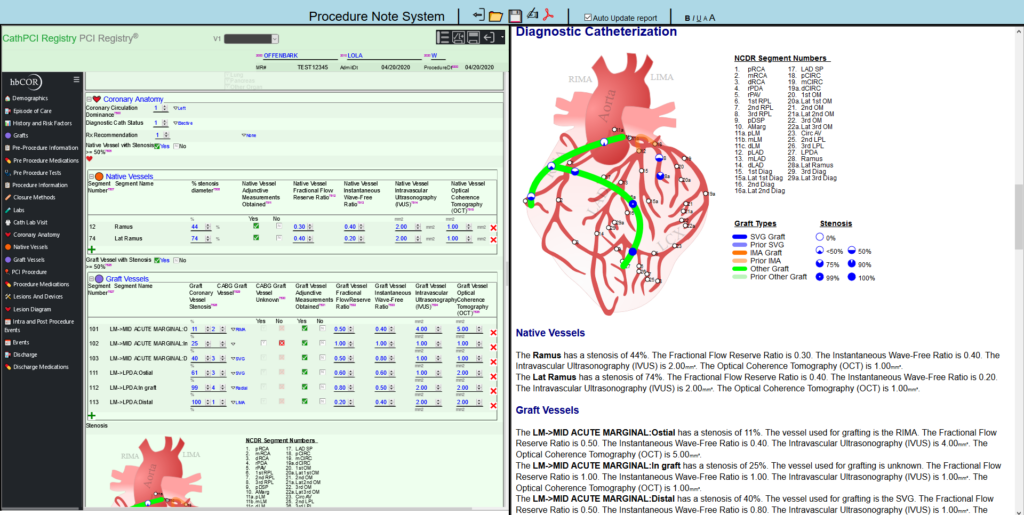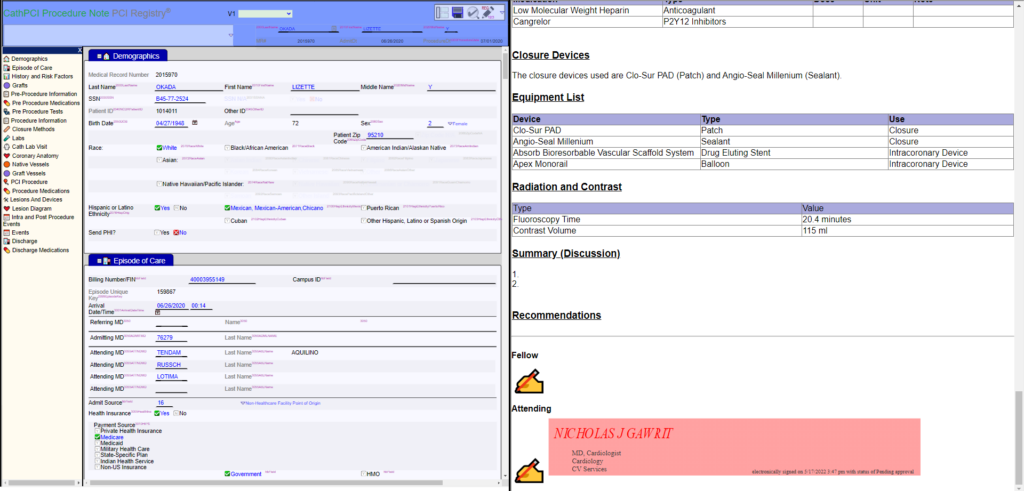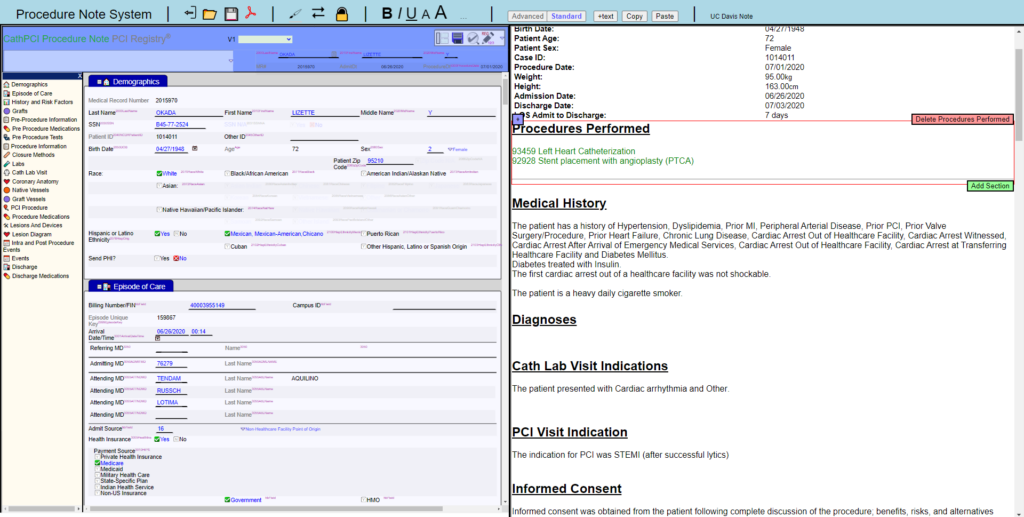hbCOR: Data Capture & Reporting
Data Entry
Yes. Heartbase takes great pride in being one of the first vendors to certify with each new registry version and actively adapts to further revisions changes as they are released.
Major “version” updates typically occur every 2-4 years per registry. Once heartbase receives the vendor specification for the updated version, the development and certification process generally takes between 4-6 weeks. Once certification is complete, heartbase installs the update and provides user training covering the specific registry changes. Typically this is performed 1-2 weeks before the go-live of the new registry version.
The national registries periodically release minor changes, such as the ACC-NCDR CathPCI COVID-19 Auxillary Fields. These changes are usually applied to the client’s system within 2-3 weeks of the finalizedcomplete specification’s release.
All version updates are provided and installed by a heartbase® support team member. Limited IT involvement is required for the life of the heartbase® project, with the exception of providing a hardware backup for the heartbase® server.
Throughout our nearly 30-year history, heartbase has worked with every historical version of each significant CV registry. Because of this wealth of experience and heartbase’s unique, longitudinal, patient-centric data model, we can migrate historical data for nearly every registry across multiple registry versions, preserving historical data definitions and allowing for reporting across the entire patient history. Heartbase uses registry harvest files for standard data migrations.
Additionally, heartbase has extensive experience importing custom historical data, including custom registries dating back to the 1970s. For custom historical data, heartbase will work with your team to map the data to the new registry, cleaning and standardizing the data wherever needed.
Yes. The heartbase solution features a vast number of data validation tools and reports:
- Single Case Audit – All heartbase data entry forms come equipped with the heartbase “Single Case Audit” tool that checks the form for data completeness, relational checks (STS ACSD), and outliers, including any custom fields incorporated into the registry. An Audit List is then automatically generated, including an interactive search feature, allowing users to navigate any outstanding fields by simply clicking the value in the list. This will highlight the item as the active field and navigate the form, so the selected field is at the top of the screen. Any field memos committed to the patient record will appear on the Audit List in green text.
- Full Registry Audit – When the user is ready to submit their data harvest to the registries, they can run the full “Registry Audit” program, which will run a full audit of all cases for the date range of the harvest. This will give a CSV output of missing fields, relational checks (STS ACSD), as well as the interactive heartbase “DataView,” which allows the users to access the registry record for data correction directly.
- Null Value Queries – The heartbase Query Tool can query any field on the registry form, including all custom fields. Using the Conditional Logic functions, users can validate any value of the selected fields, including any missing or “Null” values. This solution requires no programming knowledge and offers a simple point-and-click UI.
On-Demand CathPCI AUC & Risk Scoring, and STS NQF & Risk Calculator – Users can immediately score patients for AUC and Risk metrics upon completion of a case.
Yes, when heartbase® captures information from the real-time ADT interface from the EHR, a campus-ID is also transmitted. This campus-id is stored within each event. At the time of harvest, there is a drop-down for multi-campus databases. The user simply selects the campus they wish to harvest, and a file is generated specifically for that site.
Yes. User roles are fully customizable in heartbase, meaning that read, write, and delete permissions can be restricted at the individual field level. Read access can be similarly limited.
Additionally, hospitals can use specific role-based “User Views” which assign specific datasets to a user based on the hospital workflow, ensuring that the user only sees the data they are responsible for capturing. Roles are typically custom-tailored to each facility. Examples include: Pre-Surgical Assessment (which can be entered pre-op in the office), RN, perfusion, anesthesia, lab, and surgery teams.
Heartbase audit tools track when a change is made in the system and by whom.
Unlike other vendors, heartbase loads the full data entry form at one time – this means users never have to switch between screens.
Users can easily switch between sections of the registry form using our navigation panel and quickly search registry fields by Value Label, ShortName, or Sequence Number.
Yes, heartbase forms include access to the full registry data dictionary. Additionally, all fields offer a “Field Help” button that provides a pop-up window containing the definition, ShortName, and Sequence Number for that specific field.
Yes. Every heartbase form includes the ability to leave a “Field or Record Memo” – a custom note discrete to a particular variable or section of the data entry form.
Field memos appear in the heartbase Single Case Audit tool and the pre-harvest audit report, so users can always be reminded of their notes when performing data cleanup.
Reporting
Yes. hbCOR exports data to MS Excel, Google Sheets, CSV, TXT, PDF, DOC, DOCX, SPSS SAV, SAS, XML, CDA, and more.
If your Healthcare Intelligence teams use a data lake or have a preferred statistical toolset (Such as Tableau, Cognos, or Statit), heartbase can export flat-file data retrievals of the entire registry dataset for import into the preferred reporting tool.
Yes. With hbCOR’s hbQuery Tool, all data entry fields, including custom fields, are easily queryable using the heartbase point-and-click query tool – no programming skills using table joins, SQL, or MS Access are required, the tool automatically does that FOR you. The query tool also features several calculated fields such as Patient Age, LOS, and STS Operative Category (ProcID). Users can input conditional logic into their queries and save them for future use.
Yes. Audit Logs in both a report form and on the data entry form are available for:
- User login activity
- Data viewing – user access of a record
- Data editing – any user-level or interface update to any field
- Deletion of records
- Data source – If data is imported from an interface, that interface will be included in the audit report.
Yes. Heartbase offers User Activity and Audit reports. Tracked user activity includes: field views, field additions/changes, field deletions, and input sources (user ID or interface). These reports are generally only available to users with administrative privileges.
Yes. Heartbase has a variety of summary reports for the ACC/STS executive measures, including AUC, Risk-Adjusted Measures, NQF/MIPS, data metrics related to the STS STAR rating, and other quality performance measures. Our library features many out-of-the-box reports, including Physician/Hospital Scorecards, NQF/MIPS/AUC metrics, Risk-Adjusted Metrics, Complications/Mortality Reporting, and several registry-specific reports such as the “CP-MI Door to Balloon Timeline.” Reports can be run by network, region/division, facility, and provider with patient-level drill-through.
For example, the heartbase STS Adult Cardiac Measure Report is often used as an audit tool for STS ACSD. While heartbase cannot provide an exact STAR report, as those targets change quarter-to-quarter, an advanced drill-down (to the individual patient) report has been made available to closely mirror what the STAR report analyzes. This allows users to quickly identify potential fallouts for the metrics comprising the STAR rating.
Yes. Throughout our nearly 30-year history, heartbase has worked with every historical version of each significant CV registry. Because of this wealth of experience and heartbase’s unique, longitudinal, patient-centric data model, users can run custom ad-hoc queries with the hbQuery Tool or all-version standard reports which span multiple versions of any given registry.
Interoperability
Yes, Heartbase consumes standardized HL7 messages from EHR modules in real-time, including but not limited to ADT, Orders, Abstraction (Coding), Medications, Labs, Epic OpTime, etc., via interfaces.
We have a variety of additional interfaces from the EMR/EHR. Example solutions include:
- HL7 ADT Interface
- EHR Clinical Data Extract
- HL7 ABS Interface
- Billing Code Extract
- Financial Data Extract
Heartbase®, Inc. successfully completed IHE Connectathon Testing in January 2013, for the Retrieve Form for Data Capture(RFD) Profile. This profile enables pre-population of hbCOR forms with discrete data elements from the EHR and sends changed elements back to the EHR post entry/audit. This interface is scalable to include any coded or discrete data element from Epic Systems, Cerner, and Allscripts.
Heartbase® has also built an array of labs, medications, and other custom EHR interfaces. For data pre-population into the STS Adult Cardiac registry, the STS is very strict about allowing interfaces as specified in their contracts with both the hospital and vendor. We will need to ensure that the data elements have an exact match in definition in order to have the flow into heartbase®.
Yes. Data exported from Hemodynamic Monitoring Systems prepopulatesAll data from these interfaces are consumed to both prepopulate ACC-NCDR fields and any additional custom fields. Data from these interfaces can beare typically used to generate equipment level reports, including stent usage by the manufacturer for compliance purposes. This data is available on both the site and enterprise levels, depending on the user’s access.
Yes. Heartbase can work with hospitals to import data from a data lake, or create other custom imports from hospitals systems.
Using the heartbase EHR extract model, in which data from the EHR is automated via an MFT (manual file transfer) process-based extract, to prepopulates registry data within the heartbase application. Using a specification, provided by the heartbase team, this extract can be tailored to certain sections of the registry form such as History & Risk Factors, Medications, and Lab Results. By using an extract versus a standardized interface, the data selection and validation is far more granular, and can greatly reduce the data abstraction burden.
hbRecon: Coding Reconciliation & Revenue Capture
Yes. Heartbase imports coding, cost, and charge data from the hospital’s billing system. The linked data is available from the heartbase hbAnalytics & hbRecon platforms, allowing immediate feedback on the measures and coding mismatches that significantly impact your hospital’s bottom line. View reports by various financial parameters, including Direct Cost, Contribution Margin, Procedure Cost, Case/Mix Index, Severity of Illness, & more.
Heartbase clients obtain a return on investment in the following ways: 1) Coding Reconciliation and Rebilling with hbRecon; 2) Process Improvements through the Merged Clinical + Financial hbAnalytics; 3) Automation of Abstraction Data via Interfaces & Extracts; & 4) IT Savings through heartbase Report Development and Application Support & Maintenance. Contact sales@heartbase.net to see how heartbase can provide your facility with a positive ROI.
Heartbase leverages the fantastic granular clinical registry data to generate a predicted DRG. Heartbase also incorporates custom data elements wherever gaps exist in the standard registry data.
The CV Registry Team has a unique set of skills with a deep understanding of clinical registry data and the ability to communicate the data to various audiences. While hbRecon will flag easily actionable scenarios, there are instances where documentation from a provider is insufficient, or the data abstraction is incorrect. The CV Registry Team is equipped to work with CDI and the providers to improve documentation and ensure those mismatches are corrected.
Heartbase reviews the annual CMS Final Rule and makes necessary adjustments to hbRecon, including hierarchical changes to the DRGs and ICD-10 code exceptions.
Savings vary site-to-site. However, based on recent estimates, the average savings for ACSD cases range from $3K to $14.5 per case, and CathPCI cases range from $350 to $6,500K per case. Outliers include Impella and ECMO/Trach cases, as those cases are weighted and reimbursed at a much higher rate.
hbNote: Data-First Structured Reporting
Yes, all discrete data elements are available in the hbQuery Tool for easy-to-use point-and-click querying.
hbAnalytics: Realtime Clinical & Financial Dashboards
Clinical data is refreshed daily; coding/financial data generally is refreshed weekly or monthly – this varies for each implementation.
Yes. Heartbase imports coding, cost, and charge data from the hospital’s billing system. The linked data is available from the heartbase hbAnalytics & hbRecon platforms, allowing immediate feedback on the measures and coding mismatches that significantly impact your hospital’s bottom line. View reports by various financial parameters, including Direct Cost, Contribution Margin, Procedure Cost, Case/Mix Index, Severity of Illness, & more.
Heartbase clients obtain a return on investment in the following ways: 1) Coding Reconciliation and Rebilling with hbRecon; 2) Process Improvements through the Merged Clinical + Financial hbAnalytics; 3) Automation of Abstraction Data via Interfaces & Extracts; & 4) IT Savings through heartbase Report Development and Application Support & Maintenance. Contact sales@heartbase.net to see how heartbase can provide your facility with a positive ROI.
Yes. Heartbase offers an officially licensed ACC-NCDR CathPCI Risk-Adjusted Measure (RAM) Module & AUC Module, which includes on-demand data entry scoring, standard hbReporting, and hbAnalytics.
The ACC-NCDR requires vendors to pay a separate license fee for the risk-adjusted measures – vendors are not required to license these measures. As heartbase officially licenses these measures, the ACC-NCDR provides specifications and associated changes on an ongoing basis. Heartbase verifies risk scoring matches with a group of heartbase facilities.
Yes, all of the hbAnalytics reports contain patient-level drill-through.
Yes, hbAnalytics reports can display by a monthly breakout. All data can be displayed by Year, Quarter, or Month.
Yes, users can create custom dashboards within hbAnalytics or use the hbQuery Tool to create ad-hoc reports.
Client Support
Yes, heartbase provides numerous opportunities to keep your team informed. These items are included free of charge as part of your heartbase license, including:
- heartbeat – our monthly newsletter
- heartbase Annual Virtual User Conference – often with presentations led by heartbase users!
- Monthly online training classes on a variety of topics, including but not limited to General Data Entry, General Auditing/Harvesting, General Reporting, Lesion Complexity Analysis, DQR Analysis, AdHoc Reporting, Executive Summary Analysis
- The hbKnowledgebase, our online training platform, where users can access presentation recordings, sign up for classes, and access resource documents.
- Monthly Notices on upcoming harvest deadlines and device updates
Heartbase offers data abstraction and submission services through our partners Cardiac Registry Support (CRS) and Carta Healthcare. Heartbase clients can contract directly with these partners or access these services through the heartbase agreement.
Heartbase support is available between 7 am to 7 pm CT. Elite Service Packages are available for sites requesting extended support hours. Users have three primary means for contacting heartbase customer support:
- Heartbase Support Line: A heartbase representative will answer your call and route your request to the available support team member best suited to answer your request.
- Email Requests: Upon receipt of your email, a support ticket will be created, and a heartbase team member will be assigned to assist you.
- hbKnowledgebase: In addition to the learning resources available on the hbKnowledgebase learning portal, users can also submit and track support requests directly through the hbKnowledgebase.
Robust training is included with all heartbase services. During the project’s go-live, users will receive private, hospital-specific training tailored to the specific registries and services included in the implementation.
After go-live, ongoing training is included without additional cost. Each month, heartbase hosts several educational webinars for heartbase users. Four of these webinars are dedicated to the standard user functionality of heartbase hbCOR (Data Entry & Navigation, Audit & Harvest, and Reporting) and hbAnalytics. These standard sessions can be used to train new users or as refreshers for existing users. The remaining monthly sessions are dedicated to special topics like previews of registry updates, new heartbase functionality, specialty report training, or registry-specific case studies. These webinars and any webinars from heartbase partner groups are available to all heartbase users as part of the support agreement without any additional charge.
All heartbase clients have access to the hbKnowledgebase, an online learning platform where users can sign up for classes, view presentation recordings, watch instructional videos, and access key resource documents such as training manuals, presentation slide decks, and an archive of our monthly newsletter.
Yes. Heartbase takes great pride in being one of the first vendors to certify with each new registry version and actively adapts to future revision changes as they are released.
Major “version” updates typically occur every 2-4 years per registry. Once heartbase receives the vendor specification for the updated version, the development and certification process generally takes between 4-6 weeks. Once certification is complete, heartbase installs the update and provides user training covering the specific registry changes. Typically this is performed 1-2 weeks before the go-live of the new registry version.
The national registries periodically release minor changes, such as the ACC-NCDR CathPCI COVID-19 Auxillary Fields. These changes are usually applied to the client’s system within 2-3 weeks of the specification’s release.
Yes. Heartbase has worked with most national registries since their inception, ensuring that we can provide data migration for all historic versions throughout that registry’s history.
Heartbase will work with your hospital staff on all data migrations to ensure that the data is compatible with the heartbase database. Most commonly, data migrations are required when migrating data from a previous vendor software; however, we can also migrate custom datasets and registries
Data migrations are tracked by the heartbase Project Manager using the project tracking tool, Mavenlink. Users from the facility will have access to this tool and be assigned their appropriate validation tasks.



